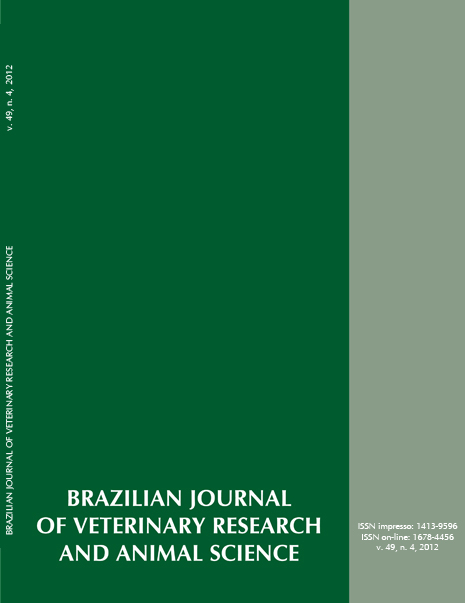In vitro oocyte transport through the oviduct of buffalo and crossbred beef cows
DOI:
https://doi.org/10.11606/issn.1678-4456.v49i4p277-284Keywords:
MOET, Oocytes, Estradiol, In vitro, BuffaloesAbstract
The present study was conducted to verify if the elevation of plasma concentrations of estradiol during superovulatory treatments affects the oocyte transport in buffalo females, as well as if the inferior quality of buffalo oocytes and/or some functional difference on the oviduct of these animals is responsible for the low embryo recovery rate in superovulated uffaloes when compared to cows subjected to the same treatment. Oviducts of 10 buffaloes and 15 of cows, treated to induce a single ovulation were used. The oviducts were placed on Petri dishes and received the following treatments: 5 buffalo oocytes with no E2 (G-BufBuf and G-BovBuf), 5 bovine oocytes with no E2 (G-BufBov and G-BovBov), 5 buffalo oocytes with E2 (G-BufE2Buf and G-BovE2Buf) and 5 bovine oocytes with E2 (G-BufE2Bov and G-BovE2Bov; factorial 2x2x2). Oocytes were incubated for 24h. Subsequently, oviducts were washed and oocytes were recovered and counted. Since no interactions were found between E2 treatment, oviducts and oocytes species, main effects were analyzed separately. Recovery rate and number of oocytes was higher on cattle compared to buffaloes (35.0+8.6% and 1.4+0.3 vs. 10.0±4.6% and 0.5±0.2, respectively; p<0.05); no effect of E2 treatment was observed on recovery rate and number of oocytes (29.8±9.0% and 1.3±0.4 vs. 16.9±6.1% and 0.7±0.2, respectively; p>0.05); the number of buffaloes and bovine oocytes recovered were similar (1.4±0.4 and 0.6±0.2, respectively; p>0.05). Oocytes recovery rate showed a trend (P=0.07) to be higher when buffalo oocytes were implanted when compared to bovine oocytes (35.2±9.2% vs. 12.9±5.4%). Present results suggest that oocyte transport by the oviduct of buffaloes and bovine was not dependent on oocytes species or E2 supplementation to the culture medium.
Downloads
Downloads
Published
Issue
Section
License
The journal content is authorized under the Creative Commons BY-NC-SA license (summary of the license: https://





